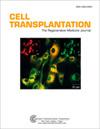用优化培养基培养的角膜间充质干细胞的抗炎治疗潜能和祖细胞标记表达得到提高
IF 3.2
4区 医学
Q3 CELL & TISSUE ENGINEERING
引用次数: 0
摘要
眼表炎症性疾病(OSID),如干眼症和睑板腺功能障碍,对新治疗模式的巨大需求尚未得到满足。间充质干细胞疗法因其强大的免疫调节特性、低免疫原性以及调节先天性和适应性免疫反应的能力,可能会成为一种答案。可从角膜基质中分离出的间充质干细胞样细胞(C-MSCs)提供了一种潜在的新治疗策略;然而,需要开发一种优化的培养基,以产生理想的表型,用于治疗OSIDs的细胞疗法。研究人员比较了人C-间充质干细胞在含有胎牛血清(FBS)的M199培养基和含有碱性成纤维细胞生长因子(bFGF)和人白血病抑制因子(LIF)的基因敲除血清替代物(KSR)的干细胞培养基(SCM)中体外扩增的效果,研究了细胞活力、蛋白质和基因表达。还研究了表达 CD34 或使用 siRNA 敲除 CD34 的分离群体。最后,通过与体外角膜上皮细胞损伤模型共培养,评估了 C-MSC 作为细胞疗法的潜力,并用血液和淋巴内皮细胞评估了 C-MSC 条件培养基的血管生成效应。两种培养基都支持 C-MSC 的增殖,SCM 可增加 CD34、ABCG2、PAX6、NANOG、REX1、SOX2 和 THY1 的表达,相关蛋白的表达也有所增加。分离表达 CD34 蛋白的细胞群对基因表达几乎没有影响,但敲除 CD34 基因会导致祖细胞基因表达减少。C-间充质干细胞提高了受伤角膜上皮细胞的存活率,同时降低了细胞毒性和白细胞介素-6 和-8 的水平。培养基会明显影响 C-MSC 的表型,而在 SCM 中培养产生的细胞表型更适合进一步考虑用作抗炎细胞疗法。通过抗炎作用,C-间充质干细胞显示出作为 OSIDs 治疗方法的巨大发展潜力。本文章由计算机程序翻译,如有差异,请以英文原文为准。
Increased Anti-Inflammatory Therapeutic Potential and Progenitor Marker Expression of Corneal Mesenchymal Stem Cells Cultured in an Optimized Propagation Medium
There is a huge unmet need for new treatment modalities for ocular surface inflammatory disorders (OSIDs) such as dry eye disease and meibomian gland dysfunction. Mesenchymal stem cell therapies may hold the answer due to their potent immunomodulatory properties, low immunogenicity, and ability to modulate both the innate and adaptive immune response. MSC-like cells that can be isolated from the corneal stroma (C-MSCs) offer a potential new treatment strategy; however, an optimized culture medium needs to be developed to produce the ideal phenotype for use in a cell therapy to treat OSIDs. The effects of in vitro expansion of human C-MSC in a medium of M199 containing fetal bovine serum (FBS) was compared to a stem cell medium (SCM) containing knockout serum replacement (KSR) with basic fibroblast growth factor (bFGF) and human leukemia inhibitory factor (LIF), investigating viability, protein, and gene expression. Isolating populations expressing CD34 or using siRNA knockdown of CD34 were investigated. Finally, the potential of C-MSC as a cell therapy was assessed using co-culture with an in vitro corneal epithelial cell injury model and the angiogenic effects of C-MSC conditioned medium were evaluated with blood and lymph endothelial cells. Both media supported proliferation of C-MSC, with SCM increasing expression of CD34, ABCG2, PAX6, NANOG, REX1, SOX2, and THY1, supported by increased associated protein expression. Isolating cell populations expressing CD34 protein made little difference to gene expression, however, knockdown of the CD34 gene led to decreased expression of progenitor genes. C-MSC increased viability of injured corneal epithelial cells whilst decreasing levels of cytotoxicity and interleukins-6 and -8. No pro-angiogenic effect of C-MSC was seen. Culture medium can significantly influence C-MSC phenotype and culture in SCM produced a cell phenotype more suitable for further consideration as an anti-inflammatory cell therapy. C-MSC show considerable potential for development as therapies for OSIDs, acting through anti-inflammatory action.
求助全文
通过发布文献求助,成功后即可免费获取论文全文。
去求助
来源期刊

Cell Transplantation
生物-细胞与组织工程
CiteScore
6.00
自引率
3.00%
发文量
97
审稿时长
6 months
期刊介绍:
Cell Transplantation, The Regenerative Medicine Journal is an open access, peer reviewed journal that is published 12 times annually. Cell Transplantation is a multi-disciplinary forum for publication of articles on cell transplantation and its applications to human diseases. Articles focus on a myriad of topics including the physiological, medical, pre-clinical, tissue engineering, stem cell, and device-oriented aspects of the nervous, endocrine, cardiovascular, and endothelial systems, as well as genetically engineered cells. Cell Transplantation also reports on relevant technological advances, clinical studies, and regulatory considerations related to the implantation of cells into the body in order to provide complete coverage of the field.
 求助内容:
求助内容: 应助结果提醒方式:
应助结果提醒方式:


